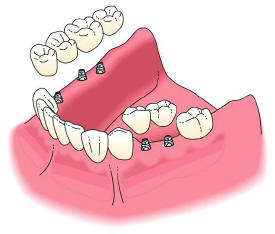




Dental implants provide a permanent solution to lost teeth. Dental implants are small screws made out of titanium to replace missing teeth. Titanium is the only metal we know that the body accepts and allows bone to grow in and around it. By placing an implant in the jaw bone (where the natural tooth root was), we can anchor replacement teeth and thus restore the patient to full function. Restoring comfort, function, esthetics and preserving the natural anatomy are the primary treatment goals in replacing missing teeth with dental implants.
Dental Implants Can Be Used to Replace Missing Teeth By:
What are the advantages of an implant over a bridge?
A dental implant provides several advantages over other tooth replacement options. In addition to looking and functioning like a natural tooth, a dental implant replaces a single tooth without sacrificing the health of neighboring teeth. The other common treatment for the loss of a single tooth, a tooth-supported fixed bridge, requires that adjacent teeth be ground down to support the cemented bridge.
Because a dental implant will replace your tooth root, the bone is better preserved. With a bridge, some of the bone that previously surrounded the tooth begins to resorb (deteriorate). Dental implants integrate with your jawbone, helping to keep the bone healthy and intact.
In the long term, a single implant can be more esthetic and easier to keep clean than a bridge. Gums can recede around a bridge, leaving a visible defect when the metal base or collar of the bridge becomes exposed. Resorbed bone beneath the bridge can lead to an unattractive smile. And, the cement holding the bridge in place can wash out, allowing bacteria to decay the teeth that anchor the bridge.
Dental implant treatments have now been researched and developed over more than 30 years. This process is now becoming more widely known and is now an established treatment option for patients throughout the world. Unlike conventional bridgework, implant treatment does not involve destructive procedures to adjoining teeth. Additional stress on adjacent teeth is therefore avoided and treatment can improve the long-term outlook for the remaining natural teeth by providing additional support to the bite. This treatment is also available in situations where conventional bridgework is not possible.
The following are but few examples of what implants can do to restore function and esthetics in your mouth.



From the time of implant placement to the time of placing the first teeth, routine treatment times are between two and six months. The availability of better bone can reduce treatment time, while more time and care must be taken with poorer bone. This can extend treatment beyond six months and if bone grafting is required, this could lengthen treatment by four to nine months. In the other extreme it may be possible to place the tooth and the implant on the same day. This is known as 'immediate loading' but can carry a higher risk of failure long term.
Once the implants and surrounding soft tissues are seen to be healthy and the new teeth comfortable and correctly adjusted, it is the quality of your home care, and willingness to present for regular maintenance reviews, that will most influence how long they will last.
When poorly cared for, implants develop a covering of deposits similar to that found on neglected natural teeth. Left untreated, these can lead to gum infection, bleeding, soreness and general discomfort, just as can occur around natural teeth. It could probably be said that implants, much like natural teeth, will last for as long as you care for them.
Well maintained implants, placed into adequate bone, can be expected to last for many years. However, just as with other surgical implants (such as a hip replacement) there is no lifetime guarantee.
For some people, bone loss after the losing teeth leaves them with too little bone to secure an implant. For those affected the following can be done:
is generally 'harvested' from the chin or back regions of the lower jaw. When you use your own bone to create new bone in another area of the mouth, you will obviously have discomfort, swelling and bruising at the donor site, as well as at the surgical site.
An easier alternative are external sources of bone, specially prepared to make them safe for use in humans. These are generally used in conjunction with resorbable membranes. These materials include synthetic, bovine, porcine or cadaveric. If you have any objection to any of these being used it is important that you make your surgeon aware. All of these materials, including your own bone, simply provide "scaffolding" into which your own new bone will grow and consolidate, ready to receive dental implants a few months later. New bone can take anything from four to nine months before it is ready to receive dental implants. Do not be in a hurry to move to the next stage as a secure footing for your implant is vital. If you need a large volume of bone it will take longer to mature. In certain situations it may be recommended to combine implant placement with bone grafting and the placement of a barrier membrane all at the same time. However, in other situations it will still be necessary to carry out bone grafting as a separate stage, so that implants are only placed once the bone grafting has been successful.